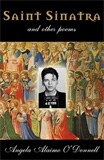September 25, 2011SAINT SINATRA
Review by Catherine Wisniewski
WordTech Communications
P.O. Box 541106
Cincinnati, OH 45254-1106
ISBN 978-1936370337
2011, 100pp., $19.00
www.word-press.com
Angela Alaimo O’Donnell’s latest book of poetry, Saint Sinatra and Other Poems, is at once both meditative and challenging. Throughout the collection, the poet-scholar imaginatively invokes the personalities of recognized and unrecognized Catholic “saints,” while artfully calling into question the traditional boundaries between the sacred and the ordinary. For O’Donnell, holiness is simply beauty, in whatever form it takes: as she observes in an interview with The Weekender, “The ‘Sinatra’ project is really about celebrating the joy and delight that beauty, in all of its forms, brings our lives.” In O’Donnell’s perspective, beauty is found in the untold struggles of traditional saints, while artists and musicians with shady pasts are canonized for the ways in which they make beauty incarnate. Ultimately, this celebration of unexpectedly sacred beauty results in a deeply Catholic poetry that is playful yet respectful, and especially alert to the sacramental aspects of the artist’s vocation.
O’Donnell blends the religious and the secular in “Saint Sinatra,” the title poem which is set apart from the book’s other six sections. Here, O’Donnell uses religious imagery against a secular backdrop to paint a new picture of this unlikely saint. It is not legendary self-mortification or remarkable works of mercy that earn Frank Sinatra a place in O’Donnell’s litany—-far from it. Instead, it is Sinatra’s “blue-eyes smiling,” “skinny legs draped/in gabardine,” and “smooth/slide down the scale of desire” that are heavenly. O’Donnell makes the argument in smooth rhythm and original rhyme for Sinatra’s “canonization”: in spite of the singer’s dubious personal life or lust-inducing performance, his music is still beautiful and therefore, in the poet’s view, an instance of art’s holy presence in everyday life.
Elsewhere, as in “St. Sinatra,” O’Donnell expands the traditional definition of “the holy” for several purposes: in order to sing the praises of musicians, literary figures, and artists (“St. Clarence,” “St. Melville,” and “St. Vincent,” to name a few) who have contributed to the world’s beauty and sacredness; to meditate on moments in Christ’s life as if she were witnessing them herself (“The Vigil” and “Mary’s Promise,”); and to bless the ordinary moments of days that become extraordinary when God’s grace is revealed (“On Seeing Van Gogh’s ‘Sower with Setting Sun’ on the Feast Day of St. Francis,” and “Waiting for Ecstasy”). But it is in Saint Sinatra’s first two sections, “Sisters” and “Brothers,” that O’Donnell’s poems approach the ideas of beauty and holiness from a decidedly different angle. In writing about some of the Catholic Church’s most beloved saints, O’Donnell adopts a tone of comfortable familiarity, employing dramatic monologue or addressing them as equals. (She even refers to St. Catherine of Siena with a nickname, affectionately titling the poem about her, “St. Kate.”) In these poems, O’Donnell uses her imagination to fill in the gaps in the biographies of these saints, often revealing the more ambiguous, human side of their personalities. She writes of Martha’s projected struggles with jealousy in “St. Martha” and speaks in Thomas Aquinas’ voice to describe a moment of clarity after much despair in “St. Thomas”:“You have set me on fire,/O my Lord, at the last,/after years of scut and cold smolder.” These poems imply that beauty, and therefore holiness, are found in the struggles each saint endures on his or her way to Heaven. These poems also make use of a distinctly Catholic vocabulary, referencing attributes, biographical information, or legends related to each saint, adding a special richness for readers familiar with these traditions.
O’Donnell’s best poems are those in which she is able to slip effortlessly into a deep sense of sustained rhythm, unifying sound and sense. While some of the longer poems do not fully achieve this level of rhythmic cohesion (“Letters to My Heart,” and “The Conversation”), this collection contains an impressive number of expertly crafted sonnets which join condensed meaning to pleasing sound. In other poems, such as “St. Lazarus,” O’Donnell creates her own special pattern of rhythm. In this poem, and several others, O’Donnell paces herself well and selects subtle slant rhymes that keep her language fresh. Of St. Lazarus’ waking from the dead, she writes, “He licks his lips and wags his muscled tongue./ Flexes each foot till the warm blood comes…” Ultimately, O’Donnell’s impressively unified book becomes an incarnation of her own creed: the fluent sound and confident rhythms of these poems, paired with O’Donnell’s profoundly Catholic and imaginative worldview, are themselves evidence of art’s compelling presence in our world.